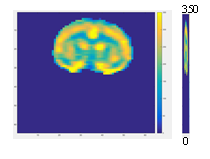Another axis of research consists in the implementation and feasibility testing of different techniques for cerebral blood perfusion measurements at 17.2 T. Among these techniques, the pseudo-continuous ASL approach (pCASL) mitigates the technical restrictions of continuous ASL and typically leads to lower RF power deposition. However, the stronger magnetic field can result in higher physiological noise and increased B0 inhomogeneity at the labeling plane, thereby limiting the inversion efficiency. We therefore work on the optimization of the acquisition protocol to maximize the latter. Our preliminary results are encouraging: pCASL leads to high signal to noise perfusion maps and CBF values in agreement to previous literature results. In parallel we are implementing other perfusion techniques with promising potential (FENSI, IVIM), which are then compared with pCASL in order to determine how the measured parameters relate to "classical" perfusion measurements.

pCASL CBF map acquired at 17.2T
© UNIRS CEA NeuroSpin